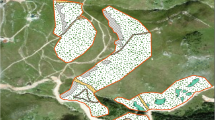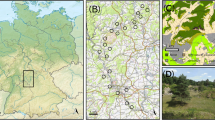Abstract
Global biodiversity hotspots are rich in endemic insect species, many of which are threatened by the ongoing anthropogenic pressures on their habitats. The Cape region (South Africa) is one of these biodiversity hotspots, maintaining a high number of endemics. However, the ecology of most insect species in this region remains poorly understood. The two Orthoptera species Betiscoides meridionalis and Betiscoides parva are endemic to the Cape region and specialized on restio vegetation. They are threatened by increasing wildfire frequencies and invasions of non-native plant species. However, this information has been inferred from habitat changes, whereas no ecological study on these species has been conducted since they have been described. In order to facilitate conservation management, information on the ecology of these species is urgently required. The aim of our study was (1) to obtain data on the population ecology (particularly population sizes and mobility), and (2) to study the behavior of both species in response to environmental factors. For this purpose a mark-recapture-study and an observational behavior study were conducted. Both species had small population sizes and a low mobility with males moving greater distances than females. Wind had a strong influence on the behavior of Betiscoides, particularly on the small males of B. parva. Future studies might thus focus on the question whether wind-exposure is a critical factor for habitat choice of this species. We strongly recommend enhancing the connectivity of restio habitats and restoring these habitats to prevent extinction of specialized insect species.





Similar content being viewed by others
References
Berggren Å (2004) Impact of grazing on individual male movement in Roesel’s Bush-Cricket Metrioptera roeseli: one possible clue to species range expansion. J Insect Behav 17:419–429. doi:10.1023/B:JOIR.0000042531.27859.ac
Buchweitz M, Walter R (1992) Individualmarkierung von Heuschrecken - ein Erfahrungsbericht. Articulata 7:55–61
Cardoso P, Erwin TL, Borges PA et al (2011) The seven impediments in invertebrate conservation and how to overcome them. Biodivers Conserv 144:2647–2655. doi:10.1016/j.biocon.2011.07.024
Cowling RM, Macdonald I, Simmons M (1996) The Cape Peninsula, South Africa: physiographical, biological and historical background to an extraordinary hot-spot of biodiversity. Biodivers Conserv 5:527–555
Diekötter T, Csencsics D, Rothenbuhler C et al (2005) Movement and dispersal patterns in the bush cricket Pholidoptera griseoaptera: the role of developmental stage and sex. Ecol Entomol 30:419–427. doi:10.1111/j.0307-6946.2005.00714.x
Dirsh VM (1965) The African genera of Acridoidea. Cambridge University Press, Cambridge
Eades D, Otte D, Cigliano M.M et al (2013) Orthoptera Species File. Version 5.0/5.0. orthoptera.speciesfile.org. Accessed 17 Oct 2013
Fric Z, Hula V, Klimova M et al (2010) Dispersal of four fritillary butterflies within identical landscape. Ecol Res 25:543–552. doi:10.1007/s11284-009-0684-4
Gardiner T, Dover J (2008) Is microclimate important for Orthoptera in open landscapes? J Insect Conserv 12:705–709. doi:10.1007/s10841-007-9104-7
Gardiner T, Hill J (2004) Directional dispersal patterns of Chorthippus parallelus (Orthoptera: Acrididae) in patches of grazed pastures. J Orthopt Res 13:135–141
Gardiner T, Hill J, Chesmore D (2005) Review of the methods frequently used to estimate the abundance of Orthoptera in Grassland ecosystems. J Insect Conserv 9:151–173. doi:10.1007/s10841-005-2854-1
Grant PB, Samways MJ (2011) Micro-hotspot determination and buffer zone value for Odonata in a globally significant biosphere reserve. Biol Conserv 144:772–781. doi:10.1016/j.biocon.2010.11.008
Gröning J, Krause S, Hochkirch A (2007) Habitat preferences of an endangered insect species, Cepero’s ground-hopper (Tetrix ceperoi). Ecol Res 22:767–773. doi:10.1007/s11284-006-0315-2
Hein S, Gombert J, Hovestadt T et al (2003) Movement patterns of the bush cricket Platycleis albopunctata in different types of habitat: matrix is not always matrix. Ecol Entomol 28:432–438. doi:10.1046/j.1365-2311.2003.00531.x
Henle K, Amler K, Biedermann R, Kaule G, Poschlod B (1999) Bedeutung und Funktion von Arten und Lebensgemeinschaften in der Planung. In: Amler K, Bahl A, Henle K et al (eds) Populationsbiologie in der Naturschutzpraxis. Ulmer, Stuttgart, pp 17–23
Hewitt GB (1979) Hatching and development of rangeland grasshoppers in relation to forage growth, temperature, and precipitation. Environ Entomol 8:24–29
Hochkirch A (1998) A comparison of the grasshopper fauna (Orthoptera: Acridoidea & Eumastacoidea) of the Uluguru Mountains and the East Usambara Mountains, Tanzania. J E Afr Nat Hist 87:221–232
Hochkirch A (2012) Betiscoides meridionalis. www.iucnredlist.org. Accessed 13 Oct 2013
Hochkirch A, Adorf F (2007) Effects of prescribed burning and wildfires on Orthoptera in Central European peat bogs. Environ Conserv 34:225–235. doi:10.1017/S0376892907004006
Hochkirch A, Gröning J, Krause S (2007a) Intersexual niche segregation in Cepero’s Ground-hopper, Tetrix ceperoi. Evol Ecol 21:727–738. doi:10.1007/s10682-006-9147-3
Hochkirch A, Witzenberger KA, Teerling A, Niemeyer F (2007b) Translocation of an endangered insect species, the field cricket (Gryllus campestris Linnaeus, 1758) in northern Germany. Biodivers Conserv 16:3597–3607. doi:10.1007/s10531-006-9123-9
Hochkirch A, Gärtner A, Brandt T (2008) Effects of forest-dune ecotone management on the endangered heath grasshopper, Chorthippus vagans (Orthoptera: Acrididae). Bull Entomol Res 98:449–456. doi:10.1017/S0007485308005762
Ingrisch S, Köhler G (1998) Die Heuschrecken Mitteleuropas. Westarp Wissenschaften, Magdeburg
Kemper J, Cowling RM, Richardson DM (1999) Fragmentation of South African renosterveld shrublands: effects on plant community structure and conservation implications. Biodivers Conserv 90:103–111
Key K (1937) New Acridiidae from South Africa. Ann S Afr Mus 32:135–167
Kindvall O (1999) Dispersal in a metapopulation of the bush cricket, Metrioptera bicolor (Orthoptera: Tettigoniidae). J Anim Ecology 68:172–185. doi:10.1046/j.1365-2656.1999.00273.x
Lactin DJ, Johnson DL (1998) Environmental, physical and behavioral determinanta of body temperature in grasshopper Nymphs (Orthoptera: Acrididae). Can Entomol 130:551–577. doi:10.4039/Ent130551-5
Larson DP, O’Neill KM, Kemp WP (1999) Evaluation of the accuracy of sweep sampling in determining grasshopper (Orthoptera: Acrididae) community composition. J Agric Urban Entomol 16:207–214
Lewis T (1969) The diversity of the insect fauna in a hedgerow and neighbouring fields. J Appl Ecol 6:453–458
Linder HP (2003) The radiation of the Cape flora, southern Africa. Biol Rev Camb Philos Soc 78:597–638
Maes D, Ghesquiere A, Logie M et al (2006) Habitat use and mobility of two threatened coastal dune insects: implications for conservation. J Insect Conserv 10:105–115. doi:10.1007/s10841-006-6287-2
Naskrecki P, Bazelet CS (2009) A species radiation among South African flightless spring katydids (Orthoptera: Tettigoniidae: Phaneropterinae: Brinckiella Chopard). Zootaxa 2056:46–62
Nielsen ET, Dreisig H (1970) The Behavior of Stridulation in Orthoptera Ensifera. Behavior 37:205–252
Odum EP, Connell CE, Davenport LB (1962) Population energy flow of three primary consumer components of old-field ecosystems. Ecology 43:88–96
Oksanen J, Kindt R, Legendre P et al (2008) The vegan package. Community ecology package. http://vegan.r-forge.r-project.org/. Accessed 13 Oct 2013
Picker M, Griffiths CL, Weaving A (2004) Field guide to insects of South Africa. Struik, Cape Town
Procheş Ş, Cowling RM (2006) Insect diversity in Cape fynbos and neighbouring South African vegetation. Global Ecol Biogeogr 15:445–451. doi:10.1111/j.1466-822X.2006.00239.x
Reinhardt K, Köhler G, Maas S et al (2005) Low dispersal ability and habitat specificity promote extinctions in rare but not in widespread species: the Orthoptera of Germany. Ecography 28:593–602. doi:10.1111/j.2005.0906-7590.04285.x
Richardson DM, van Wilgen BW (2004) Invasive alien plants in South Africa: How well do we understand the ecological impacts? S Afr J Sci 100:45–52
Sänger K (1977) Über die Beziehungen zwischen Heuschrecken und der Raumstruktur ihrer Habitate. Zool Jb Syst 104:433–488
Seddon PJ, Soorae PS, Launay F (2005) Taxonomic bias in reintroduction projects. Anim Conserv 8:51–58. doi:10.1017/S1367943004001799
Spearman L (2013) Taxonomic revision of the South African Grasshopper Genus Euloryma (Orthoptera: Acrididae). Trans Am Entomol Soc 139:1–111
Stiedl O, Bickmeyer U (1991) Acoustic behaviour of Ephippiger ephippiger fiebig (Orthoptera, Tettigoniidae) within a habitat of Southern France. Behav Process 23:125–135. doi:10.1016/0376-6357(91)90063-6
Uvarov B (1977) Grasshoppers and Locusts—a handbook of general Acridology, vol 2. Cambridge University Press, Cambridge
Venables WN, Ripley BN (2002) Modern applied statistics with S-Plus. Springer, New York
Weiss N, Zucchi H, Hochkirch A (2013) The effects of grassland management and aspect on Orthoptera diversity and abundance: site conditions are as important as management. Biodivers Conserv 22:2167–2178. doi:10.1007/s10531-012-0398-8
Weyer J, Weinberger J, Hochkirch A (2012) Mobility and microhabitat utilization in a flightless wetland grasshopper, Chorthippus montanus (Charpentier, 1825). J Insect Conserv 16:379–390. doi:10.1007/s10841-011-9423-6
White GC, Burnham KP (1999) Program MARK: survival estimation from populations of marked animals. Bird Study 46:120–139. doi:10.1080/00063659909477239
Witzenberger KA, Hochkirch A (2008) Genetic consequences of animal translocations: a case study using the field cricket, Gryllus campestris L. Biol Conserv 141:3059–3068. doi:10.1016/j.biocon.2008.09.017
Acknowledgments
We would like to thank SanParks, Eastern Cape Parks and Cape Nature for providing the permits to work in the Cape Floral Region Protected Areas. Furthermore we wish to thank Corlie Hugo, Manager of Kogelberg Nature Reserve, and Nicholaas Swarts, Manager of Limietberg Nature Reserve, for their continuous support during our studies in Kogelberg Nature Reserve and Limietberg Nature Reserve. We are also grateful to Chris Ehrke and Florian Seidt for their helpful assistance in the field. This study was funded by German Research Foundation (DFG) as a part of the PhD of Daniela Matenaar, and a travel grant by the German Academic Exchange Service (DAAD) to Linda Bröder.
Author information
Authors and Affiliations
Corresponding author
Electronic supplementary material
Below is the link to the electronic supplementary material.
Rights and permissions
About this article
Cite this article
Matenaar, D., Bröder, L., Bazelet, C.S. et al. Persisting in a windy habitat: population ecology and behavioral adaptations of two endemic grasshopper species in the Cape region (South Africa). J Insect Conserv 18, 447–456 (2014). https://doi.org/10.1007/s10841-014-9654-4
Received:
Accepted:
Published:
Issue Date:
DOI: https://doi.org/10.1007/s10841-014-9654-4




